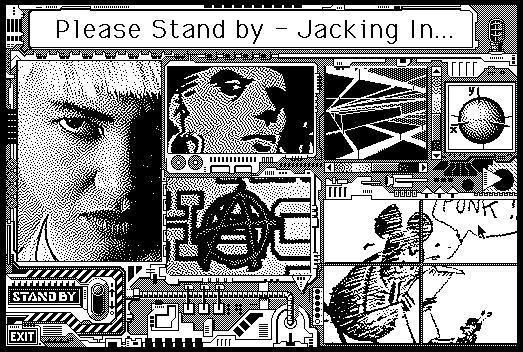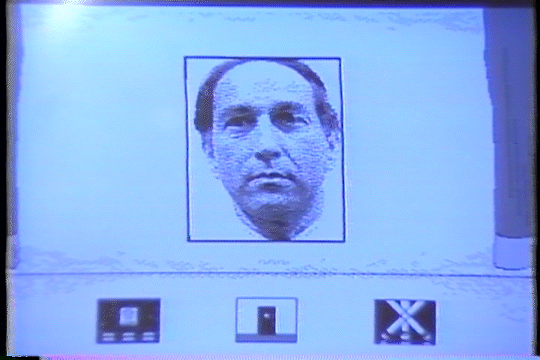#hypercard
Text

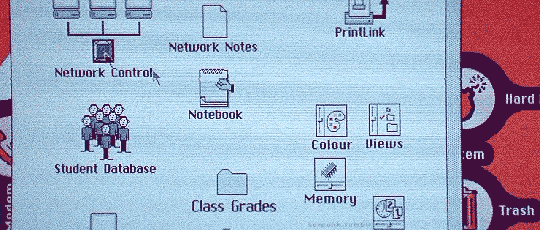




Hackers (1995)
#hackers#macintosh#cyber security#prank#funny pranks#school hacks#fire alarm#cyberpunk#cyberpunk movies#gifs#gifset#umbrella#cybersecurity#cyberspace#macos#mac os#retro computing#apple mac#hypercard
514 notes
·
View notes
Text
The internet is not a (link)dump truck

Monday (October 2), I'll be in Boise to host an event with VE Schwab. On October 7–8, I'm in Milan to keynote Wired Nextfest.

The second decade of the 21st century is truly a bounteous time. My backyard has produced a bumper crop of an invasive species of mosquito that is genuinely innovative: rather than confining itself to biting in the dusk and dawn golden hours, these stinging clouds of flying vampires bite at every hour that God sends:
https://themagnet.substack.com/p/the-magnet-081-war-with-mosquitoes
Here in the twilight of capitalism's planet-devouring, half-century orgy of wanton destruction, there's more news every day than I can possibly write a full blog post about every day, and as with many weeks, I have arrived at Saturday with a substantial backlog of links that didn't fit into the week's "Hey look at this" linkdumps.
Thus, the eighth installment in my ongoing, semiregular series of Saturday linkdumps:
https://pluralistic.net/tag/linkdump/
This week, the miscellany begins with the first hesitant signs of an emerging, post-neoliberal order. The FTC, under direction of the force-of-nature that is Lina Khan, has brought its long-awaited case antitrust case against Amazon. I am very excited about this. Disoriented, even.
When was the last time you greeted every day with a warm feeling because high officials in the US government were working for the betterment of every person in the land? It's enough to make one giddy. Plus, the New York Times let me call Amazon "the apex predator of our platform era"! Now that it's in the "paper of record," it's official:
https://pluralistic.net/ApexPredator
Now, lefties have been predicting capitalism's imminent demise since The Communist Manifesto, but any fule kno that the capitalist word for "crisis" also translates as "opportunity." Like the bedbugs that mutated to thrive in clouds of post-war DDT, capitalism has adapted to each crisis, emerging in a new, more virulent form:
https://boingboing.net/2023/09/30/bedbugs-take-paris.html
But "anything that can't go on forever will eventually stop" (Stein's Law). Perhaps our mistake was in waiting for capitalism to give way to socialism, rather than serving as a transitional phase between feudalism and…feudalism.
What's the difference between feudalism and capitalism? According to Yanis Varoufakis, it comes down to whether we value rents (income you get from owning things) over profits (income you get from doing things):
https://pluralistic.net/2023/09/28/cloudalists/#cloud-capital
By that metric, the FTC's case against Amazon is really a case against feudalism. Through predatory pricing and acquisitions, Amazon has turned itself into a chokepoint that every merchant, writer and publisher has to pass through in order to reach their customers. Amazon charges a fortune to traverse that chokepoint (estimates range from 45% to 51% of gross revenues) and then forces sellers to raise their prices everywhere else when they hike their Amazon prices so they can afford Amazon's tolls. It's "an economy-wide hidden tax":
https://www.thebignewsletter.com/p/the-ftc-sues-to-break-up-amazon-over
Now, feudalism isn't a straightforward proposition. Like, are you sure you mean feudalism? Maybe you mean "manorialism" (they're easy to mix up):
https://locusmag.com/2021/01/cory-doctorow-neofeudalism-and-the-digital-manor/
Plus, much of what we know about the "Dark Ages" comes from grifter doofuses like Voltaire, a man who was capable of dismissing the 800 year Holy Roman Empire with a single quip ("neither holy, roman, nor an empire"). But the reality is a lot more complicated, gnarly and interesting.
That's where medievalist Eleanor Janeaga comes in, and her "Against Voltaire, or, the shortest possible introduction to the Holy Roman Empire" is a banger:
https://going-medieval.com/2023/09/29/against-voltaire-or-the-shortest-possible-introduction-to-the-holy-roman-empire/
Now, while it's true that Enlightenment thinkers gave medieval times a bum rap, it's likewise true that a key element of Enlightenment justice is transparency: justice being done, and being seen to be done. One way to distinguish "modern" justice from "medieval" trials is to ask whether the public is allowed to watch the trial, see the evidence, and understand the conclusion.
Here again, there is evidence that capitalism was a transitional phase between feudalism and feudalism. The Amazon trial has already been poisoned by farcical redactions, in which every key figure is blacked out of the public record:
https://prospect.org/power/2023-09-27-redacted-case-against-amazon/
This is part of a trend. The other gigantic antitrust case underway right now, against Google, has turned into a star chamber as well, with Judge Amit P Mehta largely deferring to Google's frequent demands to close the court and seal the exhibits:
https://usvgoogle.org/trial-update-9-22
Google's rationale for this is darkly hilarious: if the public is allowed to know what's happening in its trial, this will be converted into "clickbait," which is to say, "The public is interested in this case, and if they are informed of the evidence against us, that information will be spread widely because it is so interesting":
https://www.bigtechontrial.com/p/secrecy-is-systemic
Thankfully, this secrecy is struggling to survive the public outrage it prompted. While the court's Zoom feed has been shuttered and while Judge Mehta is still all-too-willing to clear the courtroom during key testimony, at least the DoJ's exhibits aren't being sealed at the same clip as before:
https://www.theverge.com/2023/9/27/23892215/google-search-antitrust-trial-documents-public-again-judge-mehta-rules
In 2023, the world comes at you fast. There's an epic struggle over the future of corporate dominance playing out all around us. I mean, there are French antitrust enforcers kicking down doors of giant tech companies and ransacking their offices for evidence of nefarious anticompetitive plots:
https://www.theverge.com/2023/9/28/23894863/nvidia-offices-raided-french-competition-authority
As ever, the question is "socialism or barbarism." But don't say that too loud: in America, socialism is a slur, one that dates back to the Reconstruction era, when pro-slavery factions called Black voting "socialism in South Carolina."
Ever since, white nationalists used "socialism" make Americans believe that "socialism" was an "extremist" view, so they'd stand by while everyone from Joe McCarthy to Donald Trump smeared their opponents as "Marxists":
https://thehill.com/homenews/campaign/4066499-trump-paints-2024-campaign-as-righteous-crusade/
As Heather Cox Richardson puts it for The Atlantic, "There is a long-standing fight over whether support for the modern-day right is about taxes or race. The key is that it is about taxes and race at the same time":
https://www.theatlantic.com/ideas/archive/2023/09/american-socialism-racist-origins/675453/
The cruelty isn't the point, in other words. Cruelty is the tactic. The point is power. Remember, no war but class war. All of this is in service to paying workers less so that bosses and investors can have more.
Take "essential workers," everyone from teachers to zookeepers, nurses to librarians, EMTs to daycare workers. All of these "caring" professions are paid sub-living wages, and all of these workers are told that "they matter too much to earn a living wage":
https://www.okdoomer.io/praise-doesnt-pay/
The "you matter too much to pay" mind-zap is called "vocational awe," a crucial term introduced by Ettarh Fobazi in her 2018 paper:
https://www.inthelibrarywiththeleadpipe.org/2018/vocational-awe/
Vocational awe is how creative workers – like the writers who just won their strike and the actors who are still fighting – are conned into working at starvation wages. As the old joke goes, "What, and give up show-business?"
https://ask.metafilter.com/117904/Whats-the-joke-thas-hase-the-punchline-what-and-give-up-show-business
In this moment of Big Tech-driven, AI-based wage suppression, mass surveillance, corruption and inequality, perhaps we should take a moment to remind ourselves that cyberpunk was a warning, not a suggestion. Or, more to the point, the warning was about high-tech corporate takeover of our lives, and the suggestion was that we could seize the means of computation (a synonym for William Gibson's "the street finds its own use for things"):
http://www.seizethemeansofcomputation.org/
We are living in a lopsided cyberpunk future, long on high-tech corporate takeover, short of computation seizing. This point is made sharply in JWZ's "Dispatch From The Cyberpunk City," which is beautifully packaged as a Hypercard stack that you run on an in-browser Mac Plus emulator from the Internet Archive:
https://www.jwz.org/blog/2023/09/neuroblast-dispatch-from-the-cyberpunk-city/
Cast your gaze ahead, to the near future: Public space has all but disappeared. Corporate landlords use AI-powered robots to harass the homeless. The robots, built slick and white with an R2-D2 friendliness now most resemble giant butt plugs covered in graffiti and grime.
Science fiction doesn't have to be a warning. It can also be a wellspring of hope. That's what I tried to do with The Lost Cause, my forthcoming Green New Deal novel, which Bill McKibben called "The first great YIMBY novel":
https://us.macmillan.com/books/9781250865939/the-lost-cause
Writing a hopeful novel of ecological, social and economic redemption, driven by solidarity, repair, and library socialism, was a powerful tonic against despair in this smoke-smothered, flooded, mosquito-bitten time. And while the book isn't out yet, there are early indications I succeeded, like Kim Stanley Robinson's reaction, "Along with the rush of adrenaline I felt a solid surge of hope. May it go like this."
And now, we have a concurring judgment from The Library Journal, who yesterday published their review, which concludes: "a thought-provoking story, with a message of hope in a near-future that looks increasingly bleak":
https://www.libraryjournal.com/review/the-lost-cause-2196385

If you'd like an essay-formatted version of this post to read or share, here's a link to it on pluralistic.net, my surveillance-free, ad-free, tracker-free blog:
https://pluralistic.net/2023/09/30/mesclada/#melange
#pluralistic#antitrust#amazon#opacity#impunity#vocational awe#cyberpunk#dystopia watch#hypercard#jwz#holy roman empire#voltaire#enlightenment#dark ages#history#eleanor janega#linkdump#linkdumps#the lost cause#science fiction#books
170 notes
·
View notes
Text
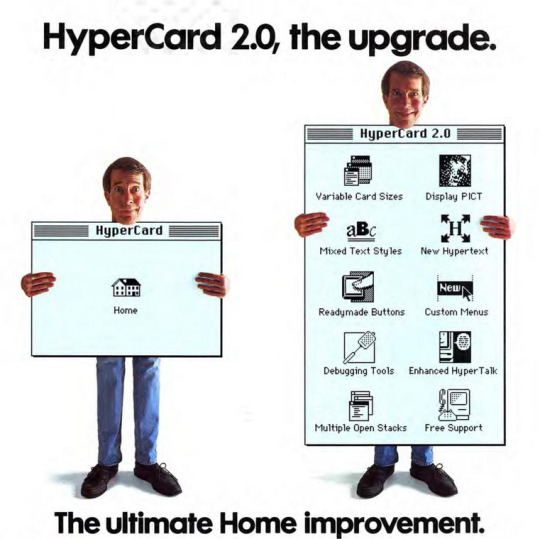
MacUser - February 1991
HyperCard 2.0
333 notes
·
View notes
Text
#even people who don't usually check out the tmbg stuff on here: this sounds great trust me!#they might be giants#hypercard#webcore#90s#audio#music
117 notes
·
View notes
Text
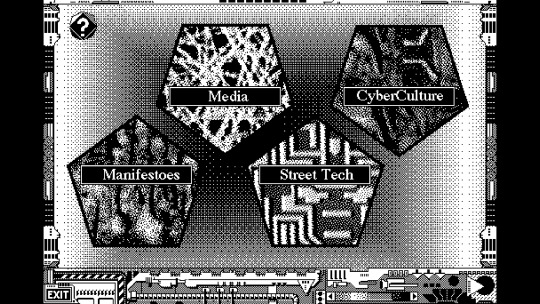


Beyond Cyberpunk Hypercard stack (1991)
103 notes
·
View notes
Text
The HyperCard Games of A. Raymond Bossert III (Classic Mac, A. Raymond Bossert III, various years)
You can download them from the developer's Waybacked website here (or the later Oocities backup here).
To run them: to to infinitemac.org and start up an in-browser emulator (this one works for me) and, once it's finished starting up, drag one the file of your choice onto the emulated desktop. (If it's TF Combat, you'll need to add .sit to the filename before dragging it). Then, open The Outside world, then Downloads. The file should apear - double-click it, then once it finishes decompressing, close Downloads and open it again to find the decompressed file's contents. (If the included instructions tell you to open a stack from within HyperCard after opening the Home stack, HyperCard is kept in Infinite HD's Multimedia folder - the 'open stack' option is in the File menu.)

#internet archive#mac#apple mac#apple macintosh#wayback machine#hypercard#game#games#video game#video games#videogame#videogames#computer game#computer games#obscure games#indie games#transformers#fan game#fan games#fangame#fangames#power rangers#parody#flashing#flashing images
7 notes
·
View notes
Text
I got all the upgraded backgrounds in my little HuperCard RPG! :)
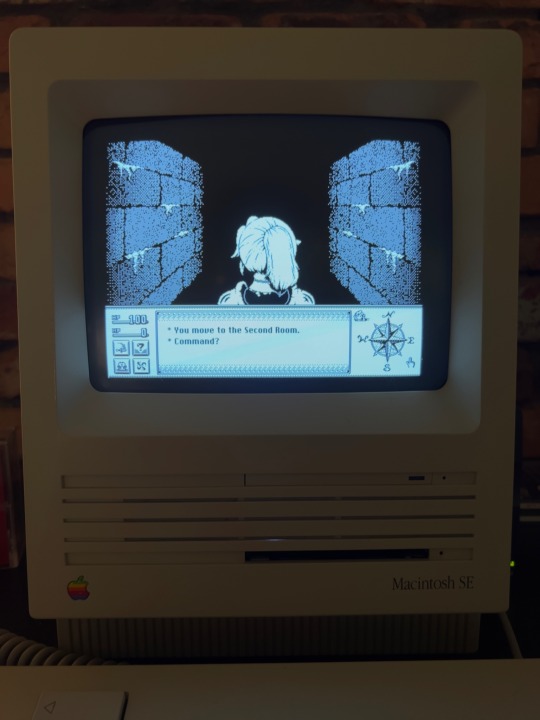

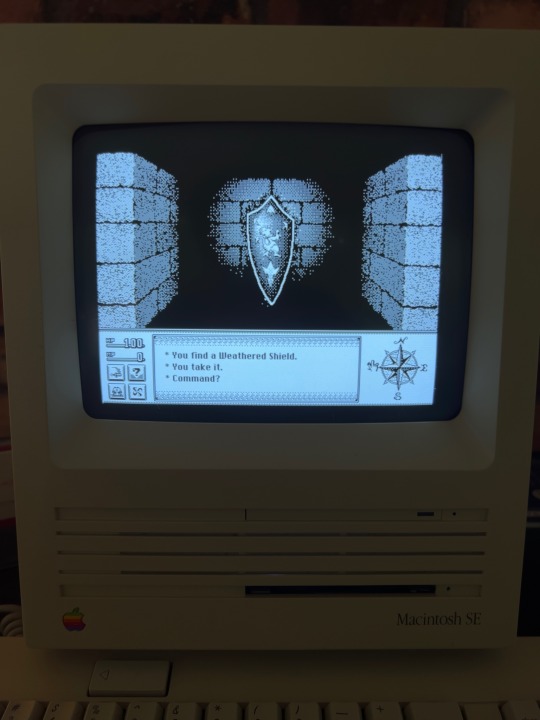

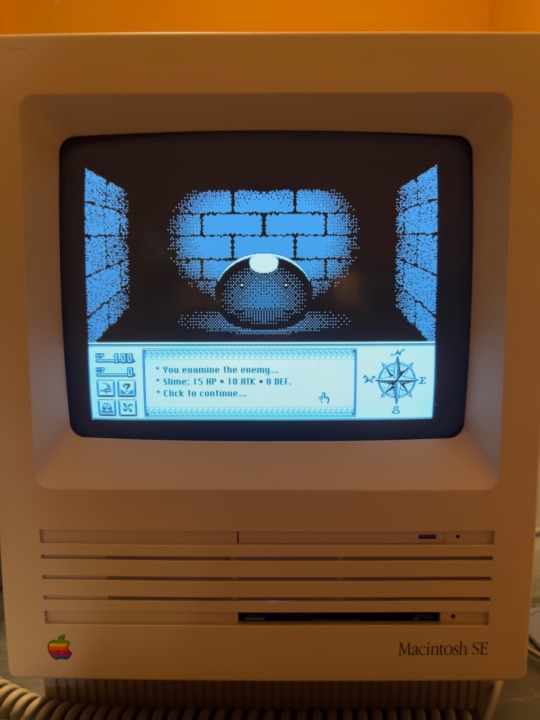
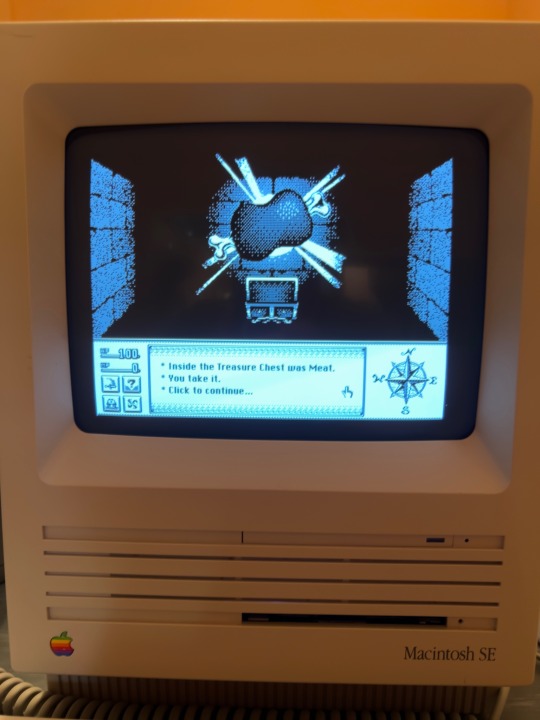
18 notes
·
View notes
Text
Apple HyperCard (1987) with Computer Chronicles clip featuring the creator, Bill Atkinson from Apple
Wikipedia -
HyperCard is a software application and development kit for Apple Macintosh and Apple IIGS computers. It is among the first successful hypermedia systems predating the World Wide Web. HyperCard combines a flat-file database with a graphical, flexible, user-modifiable interface.
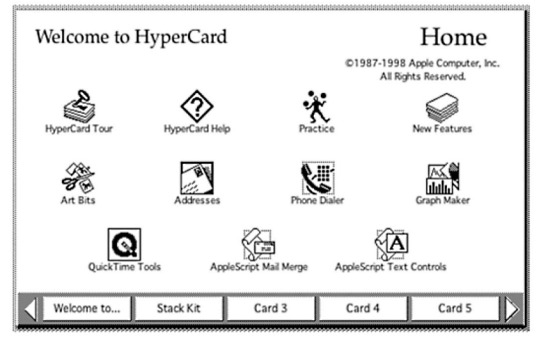

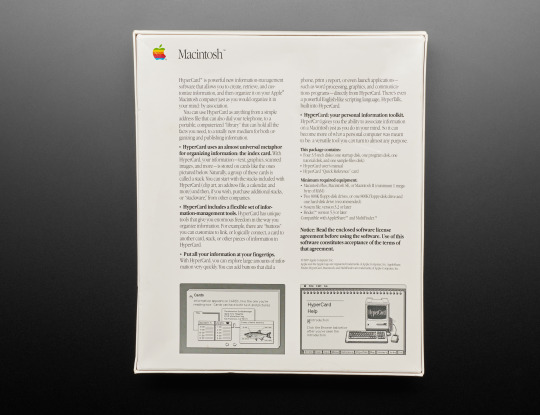
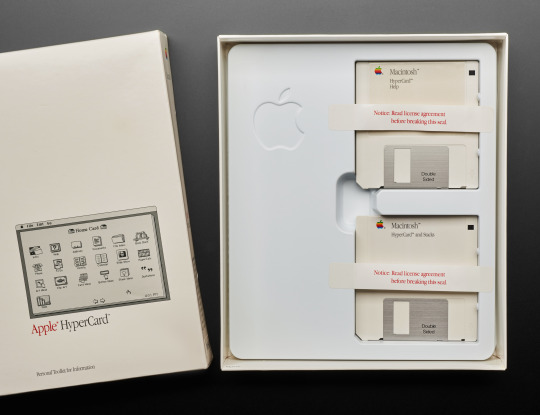
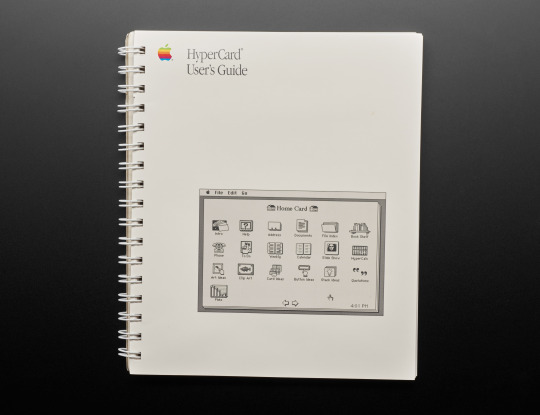

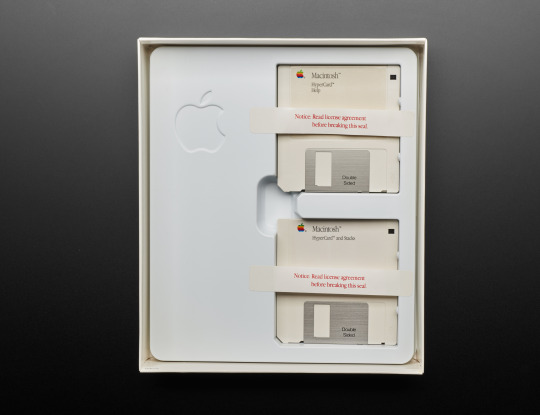




HyperCard combines a flat-file database with a graphical, flexible, user-modifiable interface. HyperCard includes a built-in programming language called HyperTalk for manipulating data and the user interface.
This combination of features – a database with simple form layout, flexible support for graphics, and ease of programming – suits HyperCard for many different projects such as rapid application development of applications and databases, interactive applications with no database requirements, command and control systems, and many examples in the demoscene.
HyperCard was originally released in 1987 for $49.95 and was then included for free with all new Macs sold. It was withdrawn from sale in March 2004, having received its final update in 1998 upon the return of Steve Jobs to Apple. HyperCard runs in the Classic Environment, but was not ported to Mac OS X.
HyperCard influenced the development of the Web in late 1990 through its influence on Robert Cailliau, who assisted in developing Tim Berners-Lee’s first Web browser. Javascript was inspired by HyperTalk.
Video and more
An introduction to Apple's Hypercard. Guests include Apple Fellow and Hypercard creator Bill Atkinson.
https://www.youtube.com/watch?v=FquNpWdf9vg
https://blog.adafruit.com/2014/06/18/hypercard/
Apple Fellow and Hypercard creator Bill Atkinson
https://en.wikipedia.org/wiki/Bill_Atkinson
https://twitter.com/billatk
https://www.youtube.com/@photocardapp
CircuitPython Your Own Adventure
https://learn.adafruit.com/circuit-python-your-own-adventure?view=all
Tons of HyperCard on the Adafruit blog!
https://blog.adafruit.com/?s=hypercard
HyperCard, the missing link to the Web
https://blog.adafruit.com/2021/06/07/34-years-of-hypercard-the-missing-link-to-the-web-hypercard-vintagecomputing-arstechnica/
The Library of Congress and HyperCard
https://blog.adafruit.com/2021/12/15/the-library-of-congress-and-hypercard-vintagecomputing-digitalpreservation-librarycongress/
DitherPaint: a 1-bit, browser-based drawing application
https://blog.adafruit.com/2021/06/09/ditherpaint-a-1-bit-browser-based-drawing-application/
Proposed Commercials featuring Mac team Members in October 1983, Full Demo Reel
https://blog.adafruit.com/2019/11/24/proposed-commercials-featuring-mac-team-members-in-october-1983-full-demo-reel-andyhertzfeld-apple/
Andy Hertzfeld has a YouTube channel
https://blog.adafruit.com/2019/07/20/andy-hertzfeld-has-a-youtube-channel-and-its-great-andyhertzfeld-billatk-susankare/
Apple Macintosh - Your Tour of HyperCard (1991) Apple Computer
https://www.youtube.com/watch?v=tx_WCIAM4bA
Explore Magic Cap, a smartphone OS from a decade before the iPhone
https://learn.adafruit.com/magic-cap-the-smartphone-os-from-the-90s?view=all
22 notes
·
View notes
Text

⌚ WristMac ⌚
"Tick Tock Tech! You're about to have the time of your life"
📂💾 https://archive.org/details/seiko-wristmac-2.0/
9 notes
·
View notes
Text






Art from Hypercard
6 notes
·
View notes
Text
How to Play HyperCard Games on Windows 10 (and Linux, OS X, etc)
so after spending some of yesterday trying to figure out how to run Caper in the Castro offline, and realizing the biggest problem was finding the right files to make it work, I've decided to write this little guide for you all!
Disclaimers: you do this at your own risk, legal stuff is complicated, this is for educational purposes only, don't pirate Apple's ancient software, etc etc
Setup:
▪ Download Mini vMac from this website (making sure to choose the correct version for your OS) and extract "Mini vMac.exe" to your folder of choice.
▪ Go here, hit "Show All" under "Download Options", and download the file "System 6.0.8.zip" and extract it.
▪ Open the extracted folder and go to the "Content" folder, then "mnvm_dat", and find the file "vMac.ROM"
▪ Copy or move that file to the same folder where you have "Mini vMac.exe"
(At this point, you can delete the rest of the files you extracted from "System 6.0.8.zip". You don't need them.)
▪ Go here, hit "Show All" again, and download "HyperCardBootSystem7.img"
▪ Download whatever HyperCard games you'd like to play.
Playing Games:
▪ Double-click "Mini vMac.exe" to open it.
▪ There will be a loud beep, and the program should open and show an image of a floppy disk with a question mark on it.
▪ Drag-and-drop "HyperCardBootSystem7.img" into the program window, and let it think about that for a second, until it says "Welcome to Macintosh" and loads up the desktop.
▪ Drag-and-drop your game disk image (for Caper in the Castro it's just "disk.img") into the window, and then open the disk when it appears.
▪ When you are done playing, exit the game ("File" -> "Quit") and then go to "Special" -> "Shut Down" to safely shut down the machine before closing the window.
Optional step: Hold down the CTRL key, and then hit the M key to make the window bigger.
and there you go! that's how to run HyperCard games on Windows 10 (or on any system that Mini vMac works on, in theory)
#hypercard#mac#tutorial#resources#emulation#mini vmac#caper in the castro#video games#look at me#capitalizing my sentences#very professional of me I know#sbs rambles#note: this has only been tested on windows 10#it's the only OS I have#your experience may vary
36 notes
·
View notes
Text
Before the web there was Hypercard
It begins with a title card. Dark grey colour over a white background. The title card could have been anything. A game, a story, a contact list, a journal of someones travels, history, geography, and so on. A card had (has) images, text and clickable areas or text which will navigate to another card. This sums up the functionality of Hypercard.
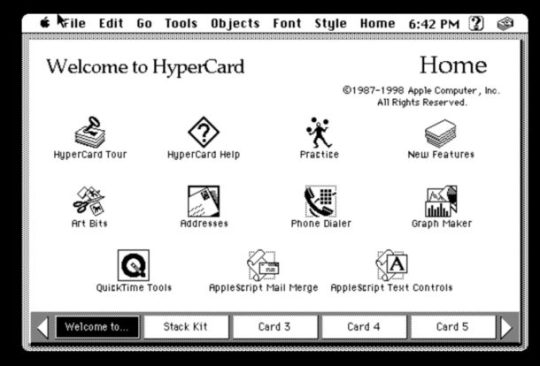
So many creative things were born out of that Application. Hypercard was just that, a collection of interactive hypercards. It was a Mac only application. It lived from 1987 up until... well, until Mac Os 9 was phased out, honestly. It had a programming language called Hyptertalk. The content you could add here was mainly images and Hypertext, which could be tagged for styling and to create hyperlinks that linked cards together.
Keep reading
3 notes
·
View notes
Text
Electronic Whole Earth Catalog: Structure to the Universe

We are as Gods, and might as well get good at it.
So far, remotely done power and glory—as via government, big business, formal education, church—has succeeded to the point where gross defects obscure actual gains. In response to this dilemma and to these gains a realm of intimate, personal power is developing—power of the individual to conduct his own education, find his own inspiration, shape his own environment, and share his adventure with whoever is interested. Tools that aid this process are sought and promoted by the WHOLE EARTH CATALOG.
The Electronic Whole Earth Catalog is a hypertext with almost 10,000 nodes, first divided into domains. The main table on contents show 13 domains. These are subdivided into sections, which are then divided into clusters (sub-sections) which contain the actual articles. The Catalog has a five leveled hierarchy of main screen, domain, section, cluster, article.
The Catalog is a HyperCard stack which uses the HyperCard background feature and its built-in backtrack facility.
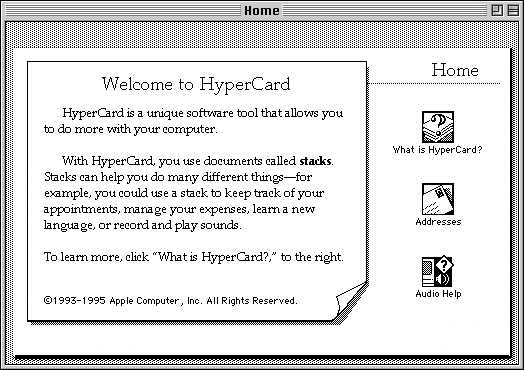
HyperCard was created by Bill Atkinson for Apple in 1987, originally was built as a graphic programming environment. It became the first successful hypermedia systems that was created before the World Wide Web.
HyperCard is based on the concept of a "stack" of virtual "cards". Cards hold data, just as they would in a rolodex. The layout engine was similar in concept to a "form" as used in most Rapid Application Development (RAD) environments (such as Borland Delphi or Visual Basic). A special "Home" stack (precursor to the home page on a website) was available as an application launcher, a repository for shared scripts, and a facility for setting preferences.
HyperCard is not only a database system. The layout of each card could be unique, just as one can write additional non-standard information on a Rolodex card. A special background layer contained elements that appeared on all cards of that stack or on all cards grouped under a certain background. Backgrounds could include pictures (its original purpose, "background picture"), in addition to the objects also available for each card: fields; buttons; (static) text; (editable) text fields; and other common GUI elements. Each card then could contain different data in the text or picture fields, as in a database.
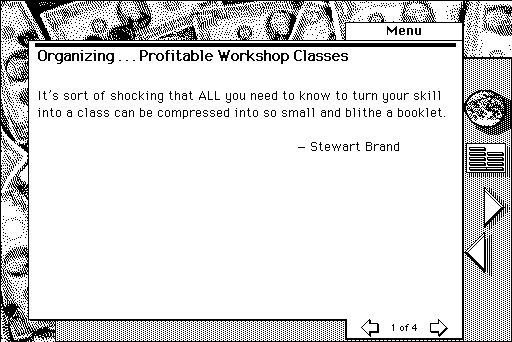
View of an Electronic Whole Earth Catalog article
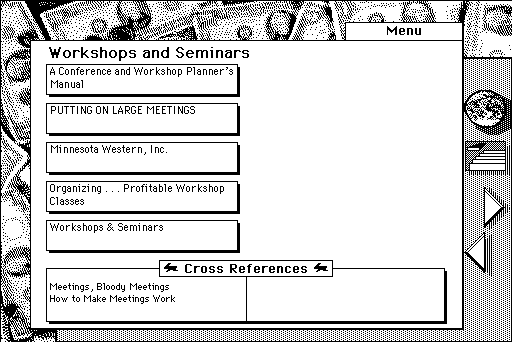
View of Electronic Whole Earth Catalogue cluster

View of a Electronic Whole Earth Catalog section
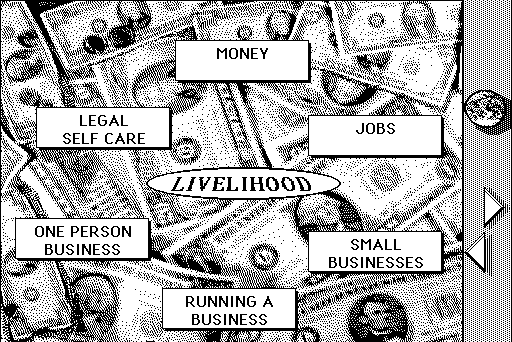
View of an Electronic Whole Earth Catalog domain

Electronic Whole Earth Catalogue full text search
2 notes
·
View notes
